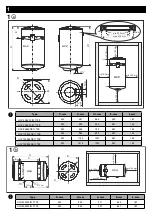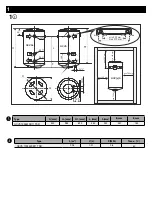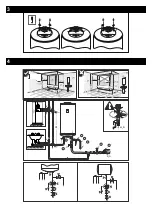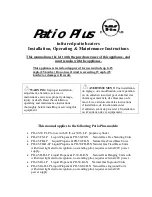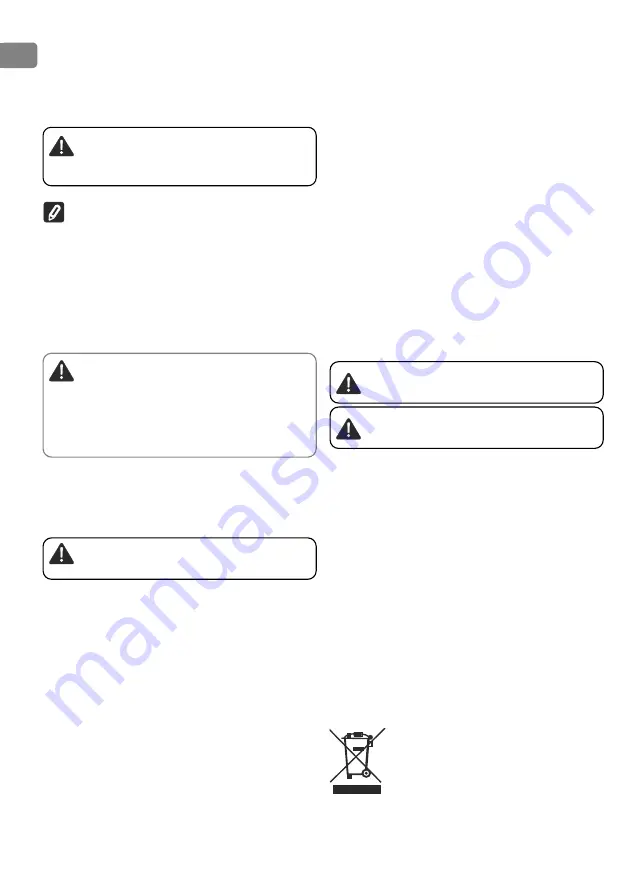
10
Instructions for use and maintenance
EN
2.2.
Temperature setup (for models with adjustable
thermostat)
This setup allows the gradual setting of the desired
temperature, achieved by using a handle on the control panel.
Turn the knob to the upward indication, in order to increase
the temperature of the hot water.
Place the thermostat knob in position for maximum
temperature (unless it is on this position constantly), for
period of one day each month - see
Table-I (h)
Thermostat temperature
setting. This ensures higher hygiene of the used hot water.
I
MPORTANT
: Models that do not have thermostat
control knobs have automatic water temperature
preset by the manufacturer .
Position
e
(Energy-save mode) – At this mode, water
temperature reaches up to approximately 60°С. Heat losses are
reduced in this way.
3.
Аnti-freezing“ function
Place the thermostat knob in position „Аnti-freezing“
according to fig.2. With this setup the device maintains
temperature that does not allow the water freeze in it.
The electrical supply of the appliance should be
turned on and so must be the appliance. The safety
valve and the pipe between the valve and the appliance must
be protected from freezing. In case that for some reason the
electrical supply is cut off, there is a risk of freezing of the
water in the water tank. For this reason we recommend
draining the water out of the appliance before long absences
(longer than a week).
4.
Protection according to the temperature (valid for all models).
The appliance is equipped with a special facility (thermal
circuit-breaker) for protection against over-heating of the
water, which is switching off the heater from the electricity
network, when the temperature reaches too high values.
When this device operates, it does not self-reset and the
appliance will not work. Please call an authorized service
for solving the problem.
VII.
MODELS EQUIPPED WITH A HEAT EXCHANGER
(SERPENTINE TUBE).
These are appliances with inbuilt heat exchanger and are
intended to be connected to the heating system with
maximum temperature of the heat carrier of 80°C.
The control over the flow through the heat exchanger is a
matter of solution for the particular installation, whereby the
choice should be made at its design (e.g. external thermostat
that measures the temperature in the water tank and operates
a circulation pump or a magnet valve).
Water heaters with a heat exchanger provide the opportunity
for the water to be heated in two ways:
1.
by means of a heat exchanger (coil) – a primary way of heating
the water,
2.
by means of an auxiliary electrical heating element with
automatic operation, built in the appliance – it is used only
when additional heating of the water is needed or in case of
repairs to the system of the heat exchanger (coil). The proper
way of connecting the appliance to the electric network
and how to work with it has been specified in the previous
paragraphs.
Mounting:
In addition to the mounting manner outlined above, especially
for the latter models, it shall be required to connect the heat
exchanger to the heating installation. The connections are to
be carried out in observance of the direction indicated by the
arrows on Fig. 1c.
Technical parameters (
table 4
:
Surface of serpentine [m²] - S;
Volume of serpentine [l] - V;
Operational pressure of serpentine [MPa] - P;
Maximum temperature of heat carrier [°C] - Tmax.
We recommend you mount stopcocks at the heat exchanger’s
entry and exit points. By stopping the flow of the thermophore
via the lower (stopcock) you shall avoid the unnecessary
circulation of the thermophore during periods of use only of the
electric heating element.
Upon disassembly of you water heater equipped with a heat
exchanger you must close both stopcocks.
There is a connexion with internal thread of ½” welded to
the water tank for the purposes of installing thermal probe –
marked with „TS”. The appliance is fitted with brass pocket for
a thermal probe which should be screwed into the aforesaid
connexion.
The usage of dielectric bushings for connecting the heat
exchanger to an installation of copper pipes is obligatory.
For ensuring minimal corrosion, pipes with a limited
diffusion of gasses must be used in the installation.
VIII.
PERIODIC MAINTENANCE
Under normal use of the heater, under the influence of high
temperature, lime scale /the so-called lime scale layer/ is
deposited upon the heating element’s surface. This worsens
the heat exchange between the heating element and water.
The heating element’s surface temperature increases along /
of boiling water/. The thermoregulator begins to switch on
and off more frequently. A ‘’deceptive” activation of the thermal
protection is possible. Due to these facts, the manufacturer
recommends preventive maintenance of your water heater
every two years by an authorized service center or service
base. This protective maintenance must include cleaning and
inspection of the anode protector (for water heaters with
glass-ceramic coating), which shall be replace with a new one
if need arises.
In order to clean the appliances use a damp cloth. Do not clean
with abrasive or solvent content detergents. Do not pour
water over the appliance.
The manufacturer does not bare the responsibility for all
consequences caused by not obeying the instructions, given
hereby.
Instructions for protecting the environment
Old electric appliances contain precious materials
and thus should not be thrown together with the
household litter. We kindly ask you make your active
contribution for protecting the resources and the
environment by handing over the appliance in the
authorized buy-back stations (if such exist).
Summary of Contents for GCH 503520 B12 TSR
Page 2: ......
Page 22: ...4 H O 2 H O 2 A 3...
Page 23: ......
Page 24: ...205881_003 TESY Ltd Shumen 9700 48 Blvd Madara PHONE 359 54 859 129 office tesy com...



















